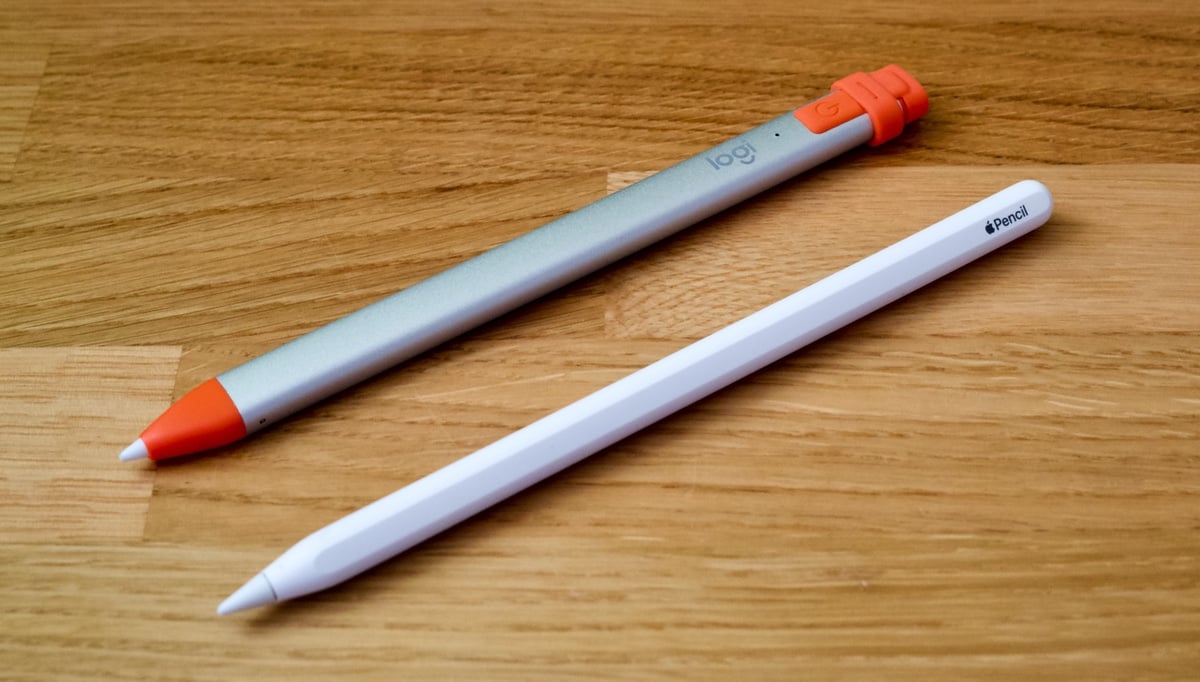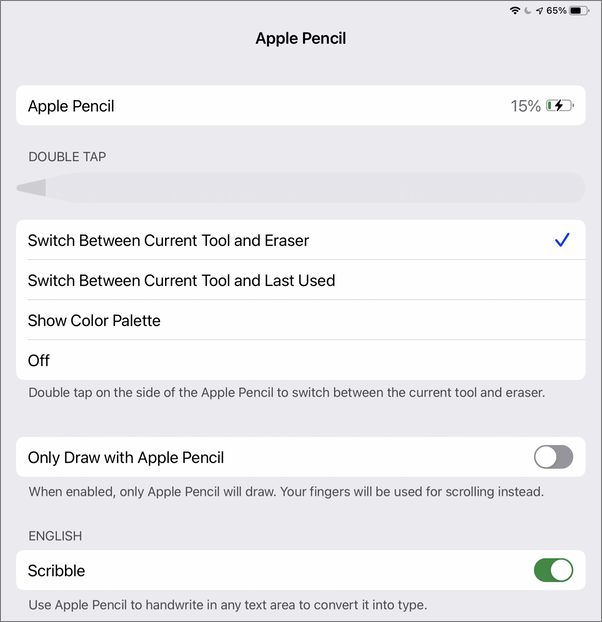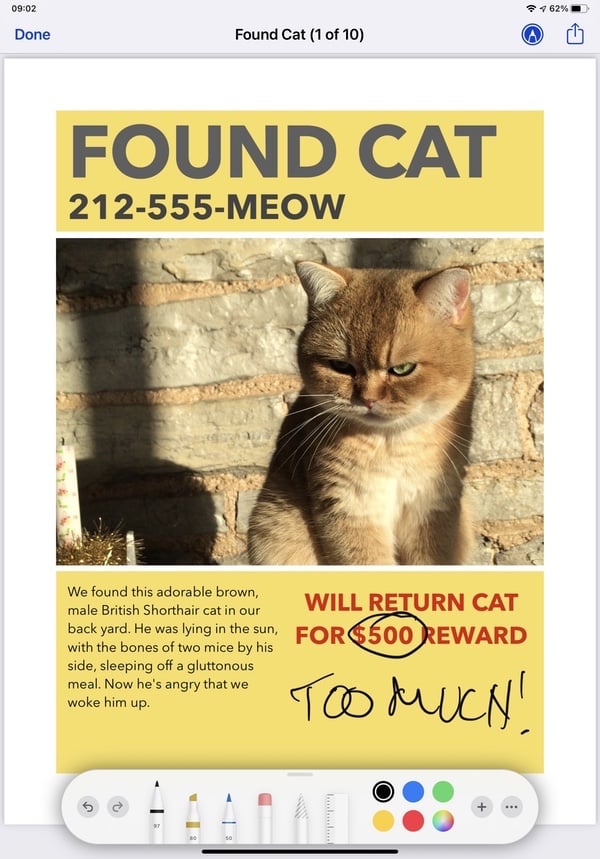How To Pair Apple Pen To Iphone
How To
Everything you can do with the Apple Pencil and Logitech Crayon on Your iPad
Posted on September 17th, 2020 by

Steve Jobs famously said, about tablets, "If you need a stylus, you've already failed." But he was talking about using a stylus as the main input device for a tablet. When Apple released the Apple Pencil in 2015, this quote was revived to remind people that a) things have changed, and b) Steve Jobs wasn't always right.
In 2018, Apple released a second version of the Apple Pencil, with more advanced features designed for the then new iPad Pro models. And Logitech also sells the Crayon, their less expensive pencil, which is compatible with certain iPads.
iOS 14 takes the Pencil further, with Scribble, a new technology that allows you to write in any location where text is accepted.
In this article I'm going to tell you everything you can do with the Apple Pencil, and the Logitech Crayon.
Compatibility
There are two different Apple Pencils, and each one has a different set of iPads it works with. The 2nd generation Apple Pencil works with iPad Pro models released late 2018 or later:

- iPad Pro 12.9-inch (3rd generation) and later
- iPad Pro 11-inch (1st generation) and later
And the first-generation Apple Pencil works with a wider range of iPad models, some of which date back to 2015:

- iPad Pro 12.9-inch (1st or 2nd generation)
- iPad Pro 10.5-inch
- iPad Pro 9.7-inch
- iPad Air (3rd generation)
- iPad (7th generation)
- iPad (6th generation)
- iPad mini (5th generation)
And the Logitech Crayon is compatible with the following iPads, from 2018 or later:

- iPad Pro 12.9-inch (4th gen)
- iPad Pro 12.9-inch (3rd gen)
- iPad Pro 11-inch (2nd gen)
- iPad Pro 11-inch (1st gen)
- iPad (7th gen)
- iPad (6th gen)
- iPad Air (3rd gen)
- iPad mini (5th gen)
The original Apple Pencil has an odd way of charging: you remove the easy-to-lose cap and stick it into a lightning port (on an iPad or iPhone), risking damage to both devices if you aren't careful.
The second-generation Apple Pencil connects magnetically to one side of the iPad Pro and powers up using induction charging. This also gives you a practical way to carry the pencil with your iPad. The magnet is strong, but I'd still be careful if you're carrying the iPad with Pencil in the open.
And to charge the Logitech Crayon, pull back the silicon cap at the end of the pencil and insert a lightning cable.
Current prices for these devices are $99 (1st generation Apple Pencil), $129 (2nd generation Apple Pencil), and $70 (Logitech Crayon).
The main difference between the Apple and Logitech devices is that the latter doesn't have pressure sensitivity, which is important if you're creating detailed drawings on your iPad; however, if you tilt the Logitech Crayon, it makes thicker lines.
Form factor
The original Apple Pencil was round all around, meaning that it would roll on a desk or table that wasn't perfectly even. The new model has one flat side, preventing unwanted movement. This change is a no-brainer; the round pencil was perhaps attractive from a design point of view but it was impractical. It's also got a matte finish which is easier to hold and less slippery than the first model. And the Logitech Pencil has an oval-shaped body; it's quite wide, which may not be comfortable to everyone, but it does stay flat on a table.
Setup
Setup for all of these devices is simple. Make sure Bluetooth is turned on. With the first-generation Apple Pencil, remove the cap, then plug its lighting connector into your iPad, then tap the Pair button. For the second-generation model, place the Apple Pencil on the magnetic side of the iPad. The iPad will immediately recognize the Pencil and pair with it. When you connect the Apple Pencil, the iPad briefly displays how much charge the device has.

For the Logitech Crayon, press and hold its power button for a second or two, until the tiny LED next to the button lights, then start writing. It pairs automatically.
Settings
There is a few settings for the Apple Pencil, and one specific setting for the second-generation model. You can double-tap the bottom third of the device to effect a change. In Settings > Apple Pencil, you can choose whether this "gesture" switches between the current tool and the eraser, between the current tool and the last one you used, or shows the color palette.

Other settings let you tell your iPad to only use your Apple Pencil or Logitech Crayon to draw, and there's a setting to activate Scribble.
Scribble
iPadOS 14 brings a new feature that takes advantage of the Apple Pencil, or the Logitech Crayon. Scribble lets you write, on your iPad, in any text area. You can write in the address bar of Safari, you can compose emails with your pencil, and you can use smart selection to select, cut, and paste text converted from your handwriting.
iPadOS uses data detectors to recognize phone numbers, dates, and addresses, so you could, for example, write a phone number, then tap it and call it. Scribble also recognizes shapes, so if you want to, for example, create a flow chart, your squares, circles, and triangles will be converted to clean shapes.
To use Scribble, just write, anywhere. If you write in Notes, you can tap the pencil with the A at the bottom of the window, then write; this tells Scribble to convert what you write to text.
The best way to see how Scribble works is to go to Settings > Apple Pencil, make sure Scribble is enabled, then tap Try Scribble. The tutorial shows what you can do with Scribble (even with my very messy handwriting, as you can see).
Getting started with Notes
![]()
Apple's Notes app is the perfect way to start using the Apple Pencil or Logitech Crayon. Create a new note, then tap the Markup icon at the top right of the screen.
Notes displays a set of tools at the bottom of the screen. You can now begin to draw or even write text. The iPad Pro offers excellent palm rejection so it doesn't think you're writing with your entire hand.
There are four drawing options: from left to write they are a pencil for handwriting recognition, a pen, a felt-tip pen and a pencil. To the right of that is an eraser, then a selection tool. Tap one of these to activate them. Tap again and you can choose the thickness of the lines and the saturation of the color.

If you want to use Scribble for handwriting recognition, tap the pencil with the A. Start writing, and Scribble will convert your handwriting to text. Use the gestures presented in the video above to erase, select, and edit text.
To add drawings in your notes, switch to one of the other tools. You have a choice of colors with black and the primary colors immediately available; tap the color wheel to choose a different color.
If you want to draw perfect shapes, such as circles and squares, draw the shape you want, and, at the end, don't lift the pencil right away; you'll see the shape snap into a perfect circle or square.
You can use the eraser tool – either by tapping it in the tools palette or by double-tapping the second-generation Apple Pencil if you've set that option – to erase anything you've drawn.
And you can use the selection tool to select an element, then tap and drag it to a new location. The selection tool doesn't give you a fine selection; it selects entire objects that you've drawn. Note that the undo and redo buttons at the bottom left of the screen allow you to step backward and forward in your actions.
Here's a great tip if you use Apple Notes. If your iPad is locked, tap it to wake up the screen and display a new note, the last note you viewed or the last note you created. You can choose which you prefer in Settings > Notes > Access Notes from Lock Screen.
But you can also use it as a stylus
While the Apple Pencil and Logitech Crayon aren't intended to be used as styluses to control the iPad, you can use them as such. For some apps, this can be very practical. You can tap buttons, drag sliders and select objects. This is great for editing photos, for example, because it is a lot easier to tap some of the small icons in complex editing apps with the Pencil than with a finger.
You can navigate the iPad Pro with the Apple Pencil or Logitech Crayon performing just about every action with the stylus. I find it particularly useful for doing the New York Times crossword. The only things you cannot do is return to your home screen or switch apps (you need to swipe up from the bottom of the device with your finger), or display Control Center (swipe down from the top right).
Annotate PDFs
You can annotate PDFs using the Apple Pencil oc Logitech Crayon either using the iOS Markup tools or with one of the many such apps available for iOS. Open a PDF, tap the Markup icon and draw. You can also sign PDFs using these devices.

Edit text
One of my favorite uses for the Apple Pencil or Logitech Crayon is editing text. Text editing on an iOS device is clumsy at best; it's hard to select items and it's even harder to drag the little lollipops at the beginning and end of a selection. With the Apple Pencil, I can easily edit texts I write, select and move text, or select text for deletion. I sometimes use the pencil to tap letters on the keyboard when I'm fixing typos or adding short words.

If you have a new iPad Pro, the Apple Pencil or Logitech Crayon is a worthwhile addition to the device. Even if you don't draw, you may find lots of uses for your pencil device and it may streamline your work with the tablet.
How can I learn more?
 Each week on the Intego Mac Podcast, Intego's Mac security experts discuss the latest Apple news, security and privacy stories, and offer practical advice on getting the most out of your Apple devices. Be sure to follow the podcast to make sure you don't miss any episodes.
Each week on the Intego Mac Podcast, Intego's Mac security experts discuss the latest Apple news, security and privacy stories, and offer practical advice on getting the most out of your Apple devices. Be sure to follow the podcast to make sure you don't miss any episodes.
You can also subscribe to our e-mail newsletter and keep an eye here on Mac Security Blog for the latest Apple security and privacy news. And don't forget to follow Intego on your favorite social media channels: Facebook, Instagram, Twitter, and YouTube.
About Kirk McElhearn
Kirk McElhearn writes about Apple products and more on his blog Kirkville. He is co-host of the Intego Mac Podcast, as well as several other podcasts, and is a regular contributor to The Mac Security Blog, TidBITS, and several other websites and publications. Kirk has written more than two dozen books, including Take Control books about Apple's media apps, Scrivener, and LaunchBar. Follow him on Twitter at @mcelhearn. View all posts by Kirk McElhearn →How To Pair Apple Pen To Iphone
Source: https://www.intego.com/mac-security-blog/everything-you-can-do-with-the-apple-pencil/
Posted by: pittmanhavess82.blogspot.com

0 Response to "How To Pair Apple Pen To Iphone"
Post a Comment